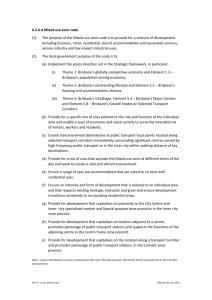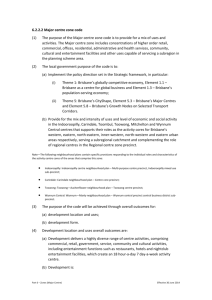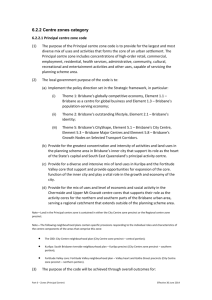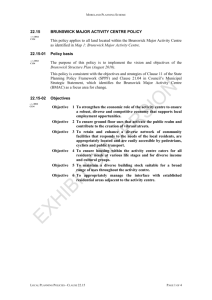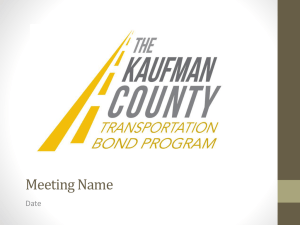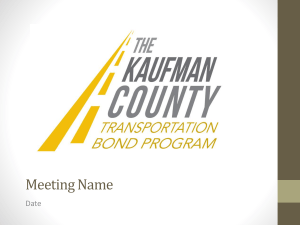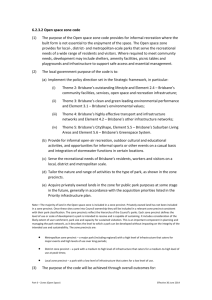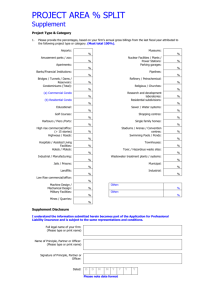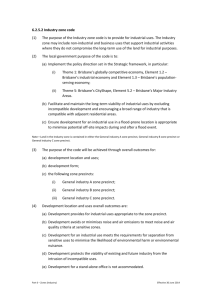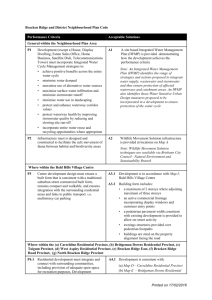District centre zone code
advertisement
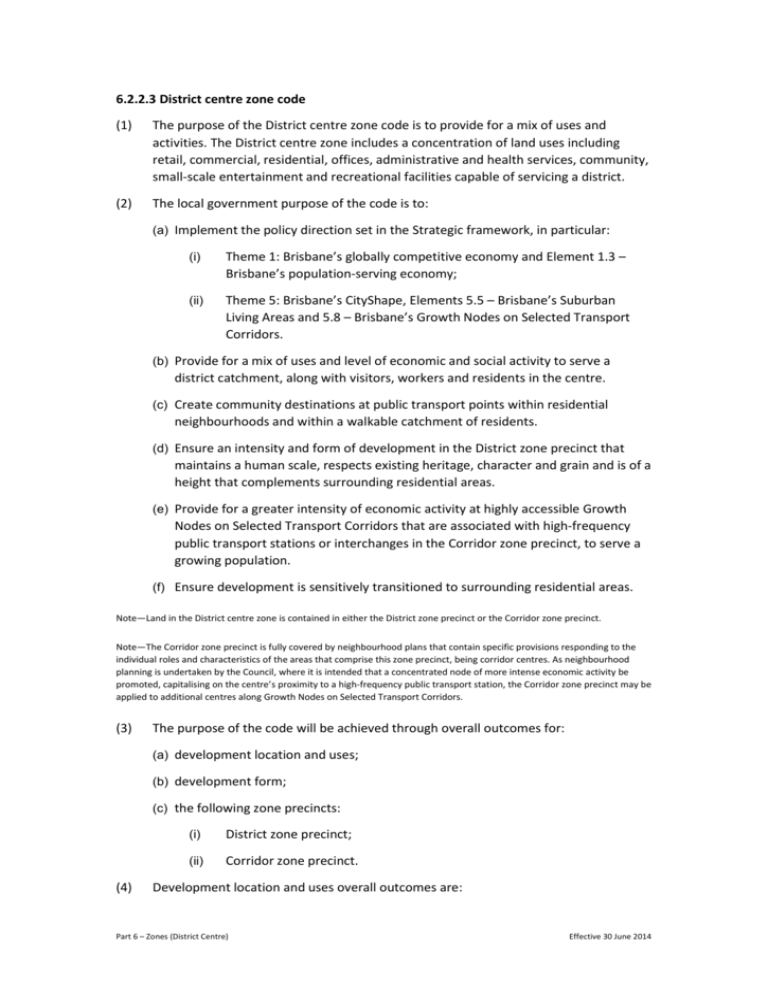
6.2.2.3 District centre zone code (1) The purpose of the District centre zone code is to provide for a mix of uses and activities. The District centre zone includes a concentration of land uses including retail, commercial, residential, offices, administrative and health services, community, small-scale entertainment and recreational facilities capable of servicing a district. (2) The local government purpose of the code is to: (a) Implement the policy direction set in the Strategic framework, in particular: (i) Theme 1: Brisbane’s globally competitive economy and Element 1.3 – Brisbane’s population-serving economy; (ii) Theme 5: Brisbane’s CityShape, Elements 5.5 – Brisbane’s Suburban Living Areas and 5.8 – Brisbane’s Growth Nodes on Selected Transport Corridors. (b) Provide for a mix of uses and level of economic and social activity to serve a district catchment, along with visitors, workers and residents in the centre. (c) Create community destinations at public transport points within residential neighbourhoods and within a walkable catchment of residents. (d) Ensure an intensity and form of development in the District zone precinct that maintains a human scale, respects existing heritage, character and grain and is of a height that complements surrounding residential areas. (e) Provide for a greater intensity of economic activity at highly accessible Growth Nodes on Selected Transport Corridors that are associated with high-frequency public transport stations or interchanges in the Corridor zone precinct, to serve a growing population. (f) Ensure development is sensitively transitioned to surrounding residential areas. Note—Land in the District centre zone is contained in either the District zone precinct or the Corridor zone precinct. Note—The Corridor zone precinct is fully covered by neighbourhood plans that contain specific provisions responding to the individual roles and characteristics of the areas that comprise this zone precinct, being corridor centres. As neighbourhood planning is undertaken by the Council, where it is intended that a concentrated node of more intense economic activity be promoted, capitalising on the centre’s proximity to a high-frequency public transport station, the Corridor zone precinct may be applied to additional centres along Growth Nodes on Selected Transport Corridors. (3) The purpose of the code will be achieved through overall outcomes for: (a) development location and uses; (b) development form; (c) the following zone precincts: (4) (i) District zone precinct; (ii) Corridor zone precinct. Development location and uses overall outcomes are: Part 6 – Zones (District Centre) Effective 30 June 2014 (a) Development creates a diverse range of centre activities, comprising commercial, retail, government, service, community and cultural activities. (b) Development is: (i) tailored to its specific location and to the role of the individual centre in the District centre zone and the relevant zone precinct; (ii) consistent with the location-specific provisions in the relevant neighbourhood plan. (c) Development provides activation and surveillance at ground level where adjoining streets and other public spaces. (d) Development for a parking station where a car park is not accommodated. (e) Development for entertainment functions being a restaurant, hotel or nightclub entertainment facility is appropriately scaled, positioned and operated to enable an 18 hour-a-day 7 day-a-week activity centre. (f) Development for a residential use: (i) does not compromise the provision of a fully active street frontage and the mix of uses required to sustain an economically and socially sustainable centre serving district needs; (ii) supports the creation of a walkable centre with the potential for residents to live within walking distance of and be well connected to high-frequency public transport and employment, entertainment and community facilities existing within the centre and reduces vehicle-based trips to work, shops or centres; (iii) provides a wide choice in housing sizes and housing adaptability that meets the needs of a diverse population and responds to residents’ changing life-cycle needs; (iv) may include a home based business where it is of a scale and nature that protects the amenity of adjoining residents. (g) Development for residential accommodation such as rooming accommodation, a residential care facility or a retirement facility may be suitable where it is consistent with the urban form and primary functions of the centre. (h) Development is designed, sited and constructed to minimise noise, odour and air- quality impacts on residents consistent with its location in the District centre zone, although residents cannot expect to enjoy the same level of noise, odour and airquality amenity as compared with low density suburban areas (due to the high levels of activity envisaged during the day and evening). (i) Development for a car wash or service station is carefully sited and designed to minimise any adverse impacts on the vibrancy of the centre and to protect surrounding residential amenity. Part 6 – Zones (District Centre) Effective 30 June 2014 (j) Development for uses that are often provided in a large-scale format such as hardware and trade supplies, garden centre or showroom: (5) (i) is limited in area and frontage; (ii) provides the level of activation and interface with the street expected of other non-residential uses in the District centre zone; (iii) does not dominate the centre or compromise its capacity to accommodate a diversity of uses. Development form overall outcomes are: (a) Development is of a scale and intensity that reflects the centre's proximity to, and frequency of, suburban public transport networks and services, and reflects the nature of the surrounding neighbourhood. (b) Development incorporates a height and setback that sensitively transitions to adjoining lower density zones or zone precincts. (c) Development provides a built form that creates a consistent and cohesive streetscape and continuous pedestrian connections and shelter. (d) Development addresses and interfaces with the street and other adjoining public spaces by incorporating active uses at ground level (with parking located below buildings) to ensure highly active streets and to provide surveillance of the public domain. (e) Development provides consistent and cohesive landscaping and streetscaping treatments, including deep planting, that reinforce the District centre zone identity, enhance the functionality of public spaces and footpaths, provide breathing space for users and encourage outdoor activity. (f) Development on an independent or large site: (i) occurs in an integrated and coordinated manner both within the site and in relation to surrounding land uses; (ii) tailors a proposal to increase gross floor area of an existing premises to respond to its specific location and to the characteristics of the site and the centre including: (A) the location of existing buildings, specialist uses and public transport interchanges; (B) access arrangements; (C) the location of and connections to active transport networks; (D) the shape, frontage, size, orientation and slope of the site; (E) local neighbourhood identity, topography and views; (F) the mix of surrounding uses; Part 6 – Zones (District Centre) Effective 30 June 2014 (G) the location of surrounding heritage places, parks and environmental features; (iii) creates an activated public domain both internally and at the centre edges, with intensive and interactive outward looking uses at ground level that maintain visual connection and physical integration with surrounding land uses; (iv) provides clear, direct, safe and comfortable internal fine-grained connectivity for pedestrians to key destinations throughout the centre, including to public transport services and active transport links that provide viable modal choice to centre users and to public spaces and connection points with surrounding land uses. (g) Development provides vehicular access arrangements that minimise impacts on surrounding land, including amenity and pedestrian connectivity, and protect the functionality of both local and higher order road networks. (h) Development is sensitively designed and operated to avoid or mitigate any potential adverse impact on an adjoining use. (i) Development responds to land constraints, mitigates any adverse impacts on environmental values and addresses other specific characteristics, as identified by overlays affecting the site or in codes applicable to the development. Note—The District centre zone accommodates two distinct built forms: groups of small tenancies within a limited area – traditional strip shopping centres and associated new infill development, usually located along busier roads and Growth Nodes on Selected Transport Corridors; larger tenancies over a broader area – usually stand-alone or independent shopping centres with a distinct population-serving catchment, often in predominantly suburban locations. While specific provisions within codes recognise these differences, the desired overall outcomes for the built form of centres, including activation and integration with their surrounds, remain the same. (6) District zone precinct overall outcomes are: (a) Development creates a centre which provides localised access to goods and services. (b) Development provides for a medium rise built form of a height similar to surrounding residential areas. (7) Corridor zone precinct overall outcomes are: (a) Development creates a mixed use centre of commercial, retail and residential activities and local services capitalising on its location at a key public transport node. (b) Development provides for a more intense built form than in the District zone precinct, with the bulk and scale of the building reflecting the purpose of the centre, its level of accessibility, position within the city, distinctive identity, desired built form and local character and values. Part 6 – Zones (District Centre) Effective 30 June 2014
